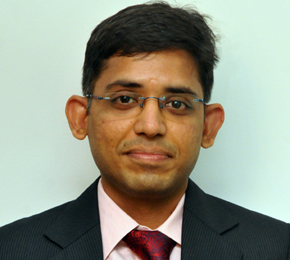Vinit is a Research Analyst focusing on sectors like Pharmaceuticals, Power Utilities, Chemicals, Fertilizers and Textiles. He is the Co-Fund Manager for DSP Blackrock Micro Cap Fund since June 2011.
Vinit Sambre joined DSPBRIM in July 2007, as Portfolio Analyst for the firm's Portfolio Management Services (PMS) division, which manages discretionary accounts and provides advisory services to institutional clients.

Previously, he was with DSP Merrill Lynch as a part of its Global Private Client business. He spent 20 months at DSP Merrill Lynch as Equity Strategist. Prior to DSP Merrill Lynch, he was employed with IL&FS Investsmart Limited as an Equity Analyst in their PMS division. Prior to that, he has worked with UTI Investment Advisory Services as Equity Analyst for the offshore fund – India Growth Fund. Vinit is a Chartered Accountant from Institute of Chartered Accountant of India (Nov'1997).
1. According to you, what are the cues in the Budget to which the markets are likely to have a sharp reaction?
Ans. In our view, the Finance Minister has announced a pragmatic and a prudent budget. The FM delivered his promise on the fiscal side which has been a cause of worry for some time. The Fiscal Deficit projection is 5.2% in FY 2013 & 4.8% in FY 2014. With the expected fiscal consolidation we expect the RBI to cut interest rates and provide support to growth.
We believe that revival in capex will be the key to raise India’s GDP growth. Some measures in the Budget in this regard are noteworthy like allocation of Rs.~ 150bn. for JNNURM scheme, constitution of a regulatory authority for the road sector, promise to award 3,000 km of road project in H1FY14, focus on coal, industrial corridors, rural road construction etc. Besides this government has taken the following measure to revive private capex, which has reached a decadal low of 5% in FY13. They have announced investment allowance of upto 15% of total investments over Rs. 100 crs. in plant and machinery during the two years ending Mar’15.
We would however closely watch any measure the government would take to resolve issues on environment clearance, land acquisition, coal mining etc. which to our belief will be the key for sustainable growth going forward.
2. What is your assessment of the earnings season so far? Do you subscribe to the view that the markets are trading below their historic average PE multiples, leaving a large scope for upside? Will pessimism in sentiment prevent such an upside?
Ans. While the third quarter corporate earnings are largely in line with the expectation on the revenue front, there was some disappointment on earnings side. Sectors such as Pharmaceuticals, Consumer staples and private sector banks have done well but were pulled down by sectors like Metals, Real Estate, PSU banks and consumer discretionary. Although we had expected the downgrade cycle to end but we have seen marginal downgrade in earnings posts the third quarter results.
Markets are trading at less than 14XFY’14 Sensex earnings estimate which we believe is below historic average PE, making the market attractive for the long term investor. Any sustained re-rating will largely depend on the steps being taken by the government on the reforms front.
3. Currently, which are the priority sectors and themes in the market? Has the capital goods sector bottomed out? Or do you expect further decline here?
Ans. We continue to prefer Financials, IT and Media. We have fair exposure in Industrial sector too as we believe that government will accelerate the reforms initiatives, interest rate cycle is expected to move downwards and valuations are near its bottom. Further decline is possible if we see delay in reform process by the government.
4.How do you ensure liquidity in funds such as DSP Blackrock Micro cap fund? How do low trading volumes or illiquidity impact the fund’s performance? Are there any measures in place to circumvent this problem?
Ans. As per the objective of the Micro Cap Fund, minimum 65% of the investment has to be in Micro Cap companies (companies not part of top 300 by market capitalization). The balance 35% can be invested across the spectrum. Hence we are able to manage the liquidity by diversifying upto 35% of our investment in mid-caps and large mid-caps. Low trading volumes in micro-cap segment does remain a challenge which we try and address by avoiding low quality business / management. This ensures that even if we have to stay put with our investment we are not stuck in low quality names.
5. How does one differentiate between the DSP BR Small and Mid cap fund and DSP BR Micro cap fund? What kinds of investors should invest in the two types of funds.
Ans. DSP BR Small and Mid cap fund focuses on larger mid-caps. It invests in companies which are not part of top 100 by Market Capitalization (minimum 65%) vs DSP BR Micro cap which invests in companies not part of top 300 by Market Capitalization (minimum 65%). This leads to different risk profiles of these two funds. Investors can choose to participate in either of them depending upon their individual risk profiles.
6. What will be your advice to retail investors in the present scenario?
Ans. As mentioned earlier the markets are trading below their historic average and hence looking attractive from long term perspective. Investors should pay attention to asset allocation and investment horizon. A systematic approach to investments is the key to successful investing.


